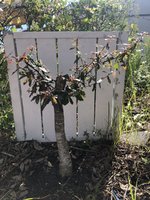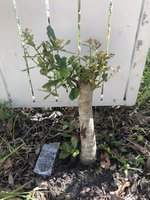Wulfskaar
Omono
Hi everyone! I have several Coast Live Oak saplings growing in my yard that can’t stay forever, so I am planning to collect between 2 and 4 of them. This is my first time doing this, so I wanted to bounce my plan off some people with experience. I have done some research but there are a few unknowns that I would like help with.
These come from several large, full-grown Coast Live Oak trees, but the main one is spectacular. It is huge and beautiful. These pictures don't do it justice. My neighbor’s tree died and was aged at 370 years and it was smaller than mine, so I would estimate mine to be at least that old. These saplings are its babies. My eventual goal in this bonsai experiment is to recreate that tree on a much smaller scale.
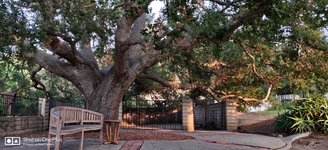
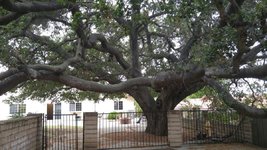

Close example of the shape I’m looking to end up with:

I’ve done some research, and this is my plan so far:
COLLECTION
When: Between November and February
How:
• Dig widely around to make sure to get as many lateral roots as possible. Cut taproot but keep lateral roots.
• Wash off ALL “native” soil from roots.
• Wash whole tree, focusing on roots, in solution of 2-3 drops of HB-101 per gallon of water.
• NOTE: They are right in my yard, so they will be going from ground to pot very quickly.
Here are a couple of my target candidates:
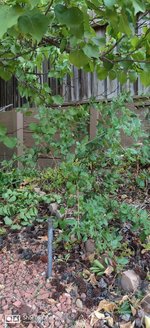

POTTING
Soil: I have heard from a Coast Live Oak bonsai expert that he has a specific mix, but he tested 41 different mixes and they mostly performed similarly. So, instead of buying several different things and mixing my own, I am thinking of just using a standard bonsai mix.
Pot: Here is where I have gotten a lot of differing information. Do I pot in a 1-gallon pot, a larger than 1-gallon pot, or straight to a bonsai pot? I have something special cooked up for the bonsai pot!
AFTER POTTING
NEXT YEAR
Spring: Defoliate and begin trimming to thicken trunk.
Late Summer: Defoliate (and trim???).
QUESTIONS
Thanks for any help you can give me! I really appreciate it!
These come from several large, full-grown Coast Live Oak trees, but the main one is spectacular. It is huge and beautiful. These pictures don't do it justice. My neighbor’s tree died and was aged at 370 years and it was smaller than mine, so I would estimate mine to be at least that old. These saplings are its babies. My eventual goal in this bonsai experiment is to recreate that tree on a much smaller scale.



Close example of the shape I’m looking to end up with:

I’ve done some research, and this is my plan so far:
COLLECTION
When: Between November and February
How:
• Dig widely around to make sure to get as many lateral roots as possible. Cut taproot but keep lateral roots.
• Wash off ALL “native” soil from roots.
• Wash whole tree, focusing on roots, in solution of 2-3 drops of HB-101 per gallon of water.
• NOTE: They are right in my yard, so they will be going from ground to pot very quickly.
Here are a couple of my target candidates:


POTTING
Soil: I have heard from a Coast Live Oak bonsai expert that he has a specific mix, but he tested 41 different mixes and they mostly performed similarly. So, instead of buying several different things and mixing my own, I am thinking of just using a standard bonsai mix.
Pot: Here is where I have gotten a lot of differing information. Do I pot in a 1-gallon pot, a larger than 1-gallon pot, or straight to a bonsai pot? I have something special cooked up for the bonsai pot!
AFTER POTTING
- Water with solution of water and HB-101 at least once per week (depending on heat) and let it sit until spring.
- Fertilize with Bayer Tree and Shrub pellets (not liquid).
- Defoliate completely twice per year, April through September.
NEXT YEAR
Spring: Defoliate and begin trimming to thicken trunk.
Late Summer: Defoliate (and trim???).
QUESTIONS
- When I dig it up and pot it…
- Do I put right into bonsai pot or big pot for allowing larger growth?
- Do I trim the roots heavily like I’ve seen on many videos?
- Should I use regular bonsai mix or try to order a special mix? Are there any pre-made soils that are appropriate for this?
Thanks for any help you can give me! I really appreciate it!

